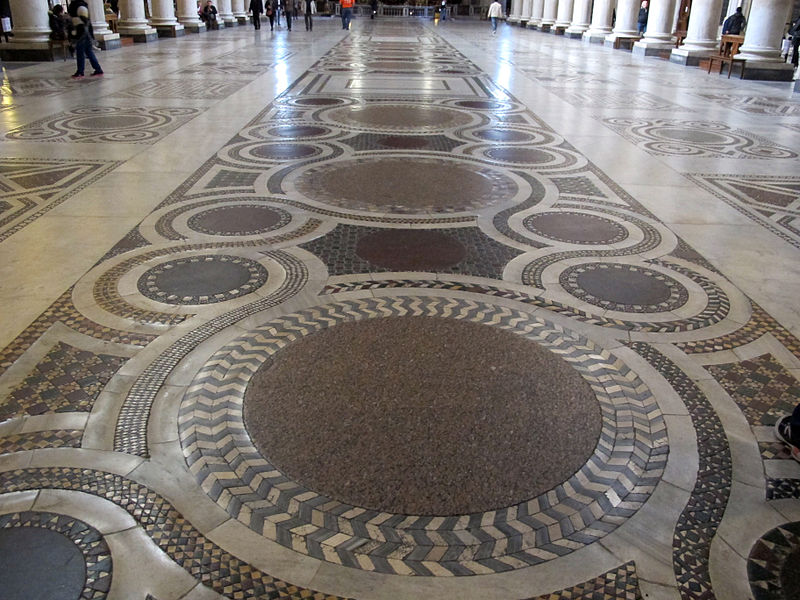Cosmati work

|
| Cosmati work on the floor of Santa Maria Maggiore in Rome. |
Contents |
[edit] Introduction
Cosmati work (also referred to as Cosmatesque) is a type of specialised decorative work that typically includes inlays of coloured stones (marbles and porphyries), glass, gilding and so on laid in a bed of mortar. Unlike mosaics, where the pieces are generally small cubes, Cosmatesque features materials of different shapes fitted together to make a pattern in a style developed in Italy.
Cosmati work was frequently used in Italian Romanesque architecture including floors, pulpits and other decorative work. It appears most frequently in buildings constructed around Rome and Naples in the 12th and 13th centuries.
[edit] The Cosmati
Roman marble workers of this period were known collectively as the Cosmati. This naming convention originates with the name “Cosma”, which is a recurring name of several families and generations of Roman marble workers.
[edit] Cosmati work in England
Cosmatesque decoration is not entirely confined to Rome, or even to Italy. There are two Cosmatesque pavements at Westminster Abbey, the finest of which is found in the sanctuary in front of the high altar. This pavement has been described as one of the pre-eminent works of art of medieval England. Some of the stones were acquired from Roman-period archaeological sites. This intricate 13th-century floor lay hidden under carpet to protect its fragile surface for over a hundred years, until a two-year restoration project (2008–10) by the abbey brought it back to life.
[edit] Related articles on Designing Buildings Wiki
IHBC NewsBlog
Old Sarum fire in listed (& disputed) WW1 Hangar - Wiltshire Council has sought legal advice after fire engulfed a listed First World War hangar that was embroiled in a lengthy planning dispute.
UK Antarctic Heritage Trust launches ‘Virtual Visit’ website area
The Trust calls on people to 'Immerse yourself in our heritage – Making Antarctica Accessible'
Southend Council pledge to force Kursaal owners to maintain building
The Council has pledged to use ‘every tool in the toolbox’ if urgent repairs are not carried out.
HE’s Research Magazine publishes a major study of the heritage of England’s suburbs
The article traces the long evolution of an internal programme to research 200 years of suburban growth
IHBC Context 183 Wellbeing and Heritage published
The issue explores issues at the intersection of heritage and wellbeing.
SAVE celebrates 50 years of campaigning 1975-2025
SAVE Britain’s Heritage has announced events across the country to celebrate bringing new life to remarkable buildings.
IHBC Annual School 2025 - Shrewsbury 12-14 June
Themed Heritage in Context – Value: Plan: Change, join in-person or online.
200th Anniversary Celebration of the Modern Railway Planned
The Stockton & Darlington Railway opened on September 27, 1825.
Competence Framework Launched for Sustainability in the Built Environment
The Construction Industry Council (CIC) and the Edge have jointly published the framework.
Historic England Launches Wellbeing Strategy for Heritage
Whether through visiting, volunteering, learning or creative practice, engaging with heritage can strengthen confidence, resilience, hope and social connections.













